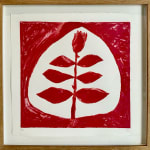Louise Bourgeois French-American, 1911-2010
Rose, 2002
lithograph
35 x 35 cm (framed)
Edition of 20 (2)
%3Cdiv%20class%3D%22artist%22%3ELouise%20Bourgeois%3C/div%3E%3Cdiv%20class%3D%22title_and_year%22%3E%3Cspan%20class%3D%22title_and_year_title%22%3ERose%3C/span%3E%2C%20%3Cspan%20class%3D%22title_and_year_year%22%3E2002%3C/span%3E%3C/div%3E%3Cdiv%20class%3D%22medium%22%3Elithograph%3C/div%3E%3Cdiv%20class%3D%22dimensions%22%3E35%20x%2035%20cm%20%28framed%29%3Cbr/%3E%0A%3C/div%3E%3Cdiv%20class%3D%22edition_details%22%3EEdition%20of%2020%20%282%29%3C/div%3E
Further images
Rose (2002) is a lithograph in red, on wove paper. Initialed in red felt-tip pen and penciled from an edition of 20, published by SOLO Impression, New York. An edition...
Rose (2002) is a lithograph in red, on wove paper. Initialed in red felt-tip pen and penciled from an edition of 20, published by SOLO Impression, New York. An edition of 'Rose' was acquired by the MoMa (edition 11 of 20) shortly after its creation.
Louise Bourgeois (b.1911 - d.2010, French-American) was a pioneering French-American artist whose work spanned sculpture, installation, painting, and printmaking. Born in Paris, Bourgeois studied at esteemed institutions including the Sorbonne, the Académie de la Grande Chaumière, the École du Louvre, and the École des Beaux-Arts before relocating to New York in the late 1940s with her husband, the art historian Robert Goldwater.
Bourgeois’ deeply personal and psychological work is often associated with the Confessional Art movement, which she helped define. Prints and works on paper provided Bourgeois with a crucial medium for exploring themes of memory, identity, sexuality, and trauma—recurring motifs throughout her long career. Bourgeois often experimented with techniques such as etching, aquatint, and lithography, pushing the boundaries of traditional printmaking.
Despite Bourgeois’ early contributions to modern and contemporary art, widespread recognition came later in her career. In 1981, the Museum of Modern Art, New York, held a retrospective of her work, and in 1993, Bourgeois represented the United States at the Venice Biennale. Tate Modern honoured her with a major retrospective in 2007, reinforcing her status as one of the most influential artists of the 20th and 21st centuries. Bourgeois was awarded France’s highest honour, the Legion of Honour, in 1998. Her legacy endures through her raw, introspective approach to form and material, which continues to resonate with contemporary audiences and artists alike.
Louise Bourgeois (b.1911 - d.2010, French-American) was a pioneering French-American artist whose work spanned sculpture, installation, painting, and printmaking. Born in Paris, Bourgeois studied at esteemed institutions including the Sorbonne, the Académie de la Grande Chaumière, the École du Louvre, and the École des Beaux-Arts before relocating to New York in the late 1940s with her husband, the art historian Robert Goldwater.
Bourgeois’ deeply personal and psychological work is often associated with the Confessional Art movement, which she helped define. Prints and works on paper provided Bourgeois with a crucial medium for exploring themes of memory, identity, sexuality, and trauma—recurring motifs throughout her long career. Bourgeois often experimented with techniques such as etching, aquatint, and lithography, pushing the boundaries of traditional printmaking.
Despite Bourgeois’ early contributions to modern and contemporary art, widespread recognition came later in her career. In 1981, the Museum of Modern Art, New York, held a retrospective of her work, and in 1993, Bourgeois represented the United States at the Venice Biennale. Tate Modern honoured her with a major retrospective in 2007, reinforcing her status as one of the most influential artists of the 20th and 21st centuries. Bourgeois was awarded France’s highest honour, the Legion of Honour, in 1998. Her legacy endures through her raw, introspective approach to form and material, which continues to resonate with contemporary audiences and artists alike.
Provenance
Galerie LeLong, Paris1
of
2
Related artworks








